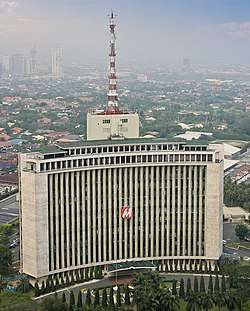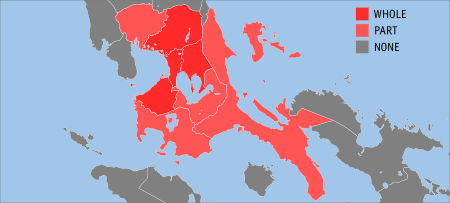Meralco
The Manila Electric Company (PSE: MER), also known as Meralco (Tagalog: [mɛɾalˈkɔ]; stylized in its logo as MERALCO), is an electric power distribution company in the Philippines. It is Metro Manila's only electric power distributor and holds the power distribution franchise for 22 cities and 89 municipalities, including the whole of the National Capital Region and the exurbs that form Mega Manila.
 | |
| Public | |
| Traded as | PSE: MER and MERB |
| Industry | Power distributor |
| Predecessor | La Electricista Compañía de los Tranvías de Filipinas |
| Founded | March 24, 1903 |
| Headquarters | Meralco Center, Ortigas Avenue, Pasig, Metro Manila, Philippines |
Key people | Manuel V. Pangilinan, Chairman Atty. Ray C. Espinosa, President and CEO |
| Owner | see list |
| Website | www |
The name "Meralco" is an acronym for Manila Electric Railroad And Light Company, which was the company's original name until 1919.
History
La Electricista
Organized in 1891 and beginning operations in late 1894, La Electricista was the first electric company to provide electricity to Manila towards the close of the Spanish era. La Electricista had built a central power plant on Calle San Sebastian (now Hidalgo Street [1][2] ) in Quiapo, Manila.[3] On January 17, 1895, its streetlights were turned on for the first time and by 1903, it had about 3,000 electric light customers.
Founding of the Manila Electric Railroad and Light Company
On October 20, 1902, during the American Colonial Period, the Second Philippine Commission began accepting bids to operate Manila's electric tramway, and by extension, providing electricity to the city and its suburbs. Detroit entrepreneur Charles M. Swift was the sole bidder and on March 24, 1903, was granted the original basic franchise of the Manila Electric Company.[4] March 24 thus is marked annually as the company's anniversary.
The Manila Electric Company acquired both La Electricista and the Compañía de los Tranvías de Filipinas, a firm that ran Manila's horse-drawn tramways which was founded in 1882.[5] Construction on the electric tramway began that same year. In addition to acquiring La Electricista's Calle San Sebastian power plant, the company built its own steam generating plant on Isla Provisora (later becoming the Manila Thermal Power Plant), which powered the tram system and eventually also the electric service. By 1906, the Manila Electric Company's annual power output capacity was around eight million kWh.
Manila Suburban Railways Company
Swift was awarded another franchise in 1906 to operate a 9.8 kilometres (6.1 mi) extension line from Paco to Fort McKinley and Pasig and founded the Manila Suburban Railway to operate this franchise.[4] In 1919 this company merged with the Manila Electric Company.[4] This extension was one of the most profitable of Meralco's lines.[4]
By the 1920, Meralco had a 170-strong fleet of streetcars, before switching over to buses later in that decade.
The company operated 52-miles of trams until World War II. The equipment and tracks of the system was severely damaged during the war and had to be removed.[6]
Power generation and distribution
By 1915, electricity generation and distribution became the main Meralco's main income generator, overtaking its public transportation operations in terms of revenue. In 1919, it changed its official name to Manila Electric Company. By 1920, the company's power capacity had grown to 45 million kWh.
In 1925, Meralco, was acquired by the utility holding company Associated Gas and Electric or AGECO (reorganized as General Public Utilities Corporation or GPU in 1946), which had begun a massive expansion throughout the United States and Canada. With AGECO's financial backing, Meralco began acquiring a number of existing utility companies in the Philippines, enabling the company to expand beyond Manila.
By 1930, Meralco had completed construction of the Philippine's first hydroelectric power plant, the 23MW Botocan Hydro Station. At the time, this plant was one of the largest engineering projects in Asia and constituted the largest single private capital investment in the Philippines. The additional capacity allowed the company to begin hooking up customers throughout the metropolitan area.
To drive demand for more power, Meralco also opened a retail store in order to sell electric home appliances.
World War II
During the Second World War, the Japanese occupying forces forcibly transferred all of Meralco's assets and holdings to the Japanese-controlled Taiwan Power Company. By war's end, most of the former Meralco facilities had been destroyed.
After the war, Meralco's autobus franchise was sold to Halili Transport.
The López group

In 1962, Don Eugenio López, Sr. acquired MERALCO and making it wholly Filipino-owned. During 1962-72, he increased MERALCO's power generating capacity by five times with the building of additional power stations in the Manila area with two more planned in Rizal Province.
In 1972, President Ferdinand Marcos declared Martial Law and issued Presidential Decree № 40, which nationalized the country's electric generation and transmission.
López's eldest son, Eugenio, Jr. ("Geny"), was arrested in order to force the elder López to turn over his businesses to President Marcos. Geny was charged for allegedly conspiring to assassinate President Marcos. With his son imprisoned, López was forced to give up his holdings in several companies worth several hundred million dollars, but Geny was not released from prison.
Ownership of MERALCO was placed under a shell company called the Meralco Foundation, Inc., controlled by Marcos associates (in particular, his brother-in-law Benjamin Romualdez), under the newly created state-run National Power Corporation (Napocor). By 1978, all of the Philippines' major power plants were owned and operated by Napocor, including the Metro Manila plants that MERALCO had built beforehand in the 1960s. State control for the company, however, began in 1975, given the company's rising debt and financial problems during the decade. By the end of the Martial Law period in 1981, MERALCO expanded even further into Cavite and western parts of Laguna, Rizal and Quezon provinces, as well as parts of southern Bulacan.
State control of MERALCO lasted until the People Power Revolution in February 1986 toppled the Marcos dictatorship. President Corazon Aquino reverted company ownership to the López Group, without them paying for the state-funded improvements done during Martial Law. She also enacted an executive order that allowed the company to directly compete with Napocor.[7] On March 18, 1989, Meralco unveiled its latest logo, which the company has been using up to the present.[8]
Controversies
2008 legislative investigation on high power rates
Meralco is facing a Philippine legislative inquiry/investigation for alleged excessive pricing.[9] The government has considered a plan to take over Meralco, to reduce electricity bills. Meralco and National Transmission Corporation (TransCo) blamed each other for the high power rates.[10] Meralco also blames high power generation costs, high transmission costs and government taxes imposed on the electricity sector from power generation to distribution. Government Service Insurance System (GSIS) President Winston García, however, blamed Meralco's inefficiency, its "bloated bureaucracy" and its sourcing of power from independent power producers (IPPs) also owned by the López Family, and the need to amend the Electric Power Industry Reform Act (EPIRA) of 2001. Oscar López said that if the GSIS would buy the Meralco shares, they must buy in whole cash, while many businessmen also said that taking over Meralco is not the way to reduce electrical price, which depends on the national government and the President. The issue was also seen as a purposeful diversion from the then-ongoing ZTE NBN scandal and other government issues.[11] A perceived lack of general understanding regarding the issue of system loss, inherent in the business of utilities prompted Meralco's former holding company, First Philippine Holdings, to issue advertisements explaining systems loss.
Syndicated estafa and bribery case
The Department of Justice (Philippines) filed syndicated (fraud) charges against Meralco in its August 22, 2008 31-page resolution, filed with the Pasig Regional Trial Court. The May 29 National Association of Electricity Consumers for Reform (Nasecore) complaint accused Meralco of "illegally declaring as income ₱889 million in consumers’ money, which represents interest from meter and bill deposits consumers had been paying since 1995."[12] No bail was recommended for all the accused, 2006 officers of Meralco, to wit: Meralco chairman and CEO Manuel Lopez, executive vice president and chief financial officer Daniel Tagaza, first Vice-resident and treasurer Rafael Andrada, vice president and corporate auditor and compliance officer Helen De Guzman, vice president and assistant comptroller Antonio Valera, and senior assistant vice president and assistant treasurer Manolo Fernando; 2006 Meralco directors Arthur Defensor Jr., Gregory Domingo, Octavio Victor Espiritu, Christian Monsod, Federico Puno, Washington Sycip, Emilio Vicens, Francisco Viray and former Prime Minister Cesar Virata.
Nasecore's complaint accusing Meralco of "illegally declaring as income 889 million pesos in consumers’ money, which represents interest from meter and bill deposits consumers had been paying since 1995," was immediately refuted by the accused company as the alleged ₱889 million only stemmed from a generally accepted accounting principle of reversing Meralco's earlier provision for meter deposit interests which, earlier set at 10% per annum was deemed too high and was set to the recommended 6%.[13] Meralco also questioned how a syndicated estafa case can arise when it has already announced and committed that it will be refunding to customers who paid meter deposit principals plus interest months ahead of the ERC prescribed schedule and has allocated enough funds for the said refund.
Meralco is also involved in the GSIS-Meralco bribery case.[14]
Dismissal of syndicated estafa case
On October 6, 2008, the Pasig City Regional Trial Court Branch 71 dismissed the syndicated estafa case filed against the Meralco board of directors, for the prosecution failed to establish all the elements of syndicated estafa.
Presiding Judge Franco Falcon, pointed out in the ruling that the board is not the kind described by the law as being formed to perpetrate an illegal act for the board of directors were elected by stockholders. The court explained, “Therefore, the accused can never be charged of taking part in the commission of syndicated estafa not only because they are not part of a syndicate as contemplated by law in PD 1689, but more so, because there was absolutely no estafa committed.”
According to Philippine law, to constitute syndicated estafa, the subject money or property must be received by the offenders. The money represents the accrued interests on the bill and meter deposits, which were paid by Meralco customers, not directly to the board, but to the various Meralco business centers where the customers transacted. Meralco expressed elation over the dismissal.[15]
Service area

Meralco serves Metro Manila, where it is the sole electricity distributor, as well as some nearby provinces, like Bulacan, Cavite, Laguna, Batangas, Rizal, and Quezon. Bulacan, Cavite, and Rizal are solely served by Meralco, but on some provinces, it only serves some parts, like in Laguna, Batangas, and Quezon, where most or some areas are served by electric cooperatives. In Laguna and Quezon, most part of those provinces are served by the company, but other areas, mostly rural municipalities, are served by electric cooperatives. In Batangas, only Santo Tomas, the First Philippine Industrial Park and First Industrial Township SEZ both in Tanauan, Batangas City, San Pascual and parts of Laurel (Barangays of Niyugan and Dayap Itaas) and Calaca (parts of Barangay Cahil) which facing Tagaytay–Nasugbu Highway are served by Meralco, and the rest of the province are franchise areas of electric cooperatives.
_25.jpg)
| City/Municipality | Province/Metropolitan Area |
|---|---|
| Caloocan | Metro Manila |
| Las Piñas | Metro Manila |
| Makati | Metro Manila |
| Malabon | Metro Manila |
| Mandaluyong | Metro Manila |
| Manila | Metro Manila |
| Marikina | Metro Manila |
| Muntinlupa | Metro Manila |
| Navotas | Metro Manila |
| Parañaque | Metro Manila |
| Pasay | Metro Manila |
| Pasig | Metro Manila |
| Pateros | Metro Manila |
| Quezon City | Metro Manila |
| San Juan | Metro Manila |
| Taguig | Metro Manila |
| Valenzuela | Metro Manila |
| Angat | Bulacan |
| Balagtas | Bulacan |
| Bocaue | Bulacan |
| Bulacan | Bulacan |
| Bustos | Bulacan |
| Calumpit | Bulacan |
| Guiguinto | Bulacan |
| Hagonoy | Bulacan |
| Malolos | Bulacan |
| Marilao | Bulacan |
| Meycauayan | Bulacan |
| Norzagaray | Bulacan |
| Obando | Bulacan |
| Pandi | Bulacan |
| Paombong | Bulacan |
| Plaridel | Bulacan |
| Pulilan | Bulacan |
| San Ildefonso | Bulacan |
| San Jose Del Monte | Bulacan |
| San Miguel | Bulacan |
| San Rafael | Bulacan |
| Santa Maria | Bulacan |
| Batangas | Batangas |
| San Pascual | Batangas |
| Santo Tomas | Batangas |
| Alfonso | Cavite |
| Amadeo | Cavite |
| Bacoor | Cavite |
| Carmona | Cavite |
| Cavite | Cavite |
| Dasmariñas | Cavite |
| General Emilio Aguinaldo | Cavite |
| General Mariano Alvarez | Cavite |
| General Trias | Cavite |
| Imus | Cavite |
| Indang | Cavite |
| Kawit | Cavite |
| Magallanes | Cavite |
| Maragondon | Cavite |
| Mendez | Cavite |
| Naic | Cavite |
| Noveleta | Cavite |
| Rosario | Cavite |
| Silang | Cavite |
| Tagaytay | Cavite |
| Tanza | Cavite |
| Ternate | Cavite |
| Trece Martires | Cavite |
| Alaminos | Laguna |
| Bay | Laguna |
| Cabuyao | Laguna |
| Calamba | Laguna |
| Calauan | Laguna |
| Liliw | Laguna |
| Los Baños | Laguna |
| Luisiana | Laguna |
| Magdalena | Laguna |
| Majayjay | Laguna |
| Nagcarlan | Laguna |
| Pila | Laguna |
| Rizal | Laguna |
| San Pablo | Laguna |
| San Pedro | Laguna |
| Santa Cruz | Laguna |
| Santa Rosa | Laguna |
| Victoria | Laguna |
| Candelaria | Quezon |
| Dolores | Quezon |
| Lucban | Quezon |
| Lucena | Quezon |
| Mauban | Quezon |
| Pagbilao | Quezon |
| Sampaloc | Quezon |
| San Antonio | Quezon |
| Sariaya | Quezon |
| Tayabas | Quezon |
| Tiaong | Quezon |
| Angono | Rizal |
| Antipolo | Rizal |
| Baras | Rizal |
| Binangonan | Rizal |
| Cainta | Rizal |
| Cardona | Rizal |
| Jalajala | Rizal |
| Morong | Rizal |
| Pililla | Rizal |
| Rodriguez | Rizal |
| San Mateo | Rizal |
| Tanay | Rizal |
| Taytay | Rizal |
| Teresa | Rizal |
Ownership
- Beacon Electric Asset Holdings, Inc.: 34.96%
- JG Summit Holdings, Inc.: 29.56%
- Metro Pacific Investments Corporation: 10.5%
- First Philippine Holdings Corporation: 3.94%
- First Philippine Utilities Corporation: 0.01%
- Others/Public stock: 21.03%
Sports teams
- Meralco Reddy Kilowatts (MICAA basketball team)
- Meralco Bolts (PBA team)
- FC Meralco Manila (Philippines Football League team)
- Meralco Power Spikers (Shakey's V-League and Philippine Super Liga team)
References
- Martinez, Glenn. "Old street names of Manila". Traveller on foot. Wordpress.
- Ivan. "Manila then and now". Blog. Ivan Lakwatsero. Retrieved December 20, 2013.
- "Calle San Sebastian - Old photos". Flickr. August 22, 2009. Retrieved December 20, 2013.
- Satre, Gary L. (June 1998). "The Metro Manila LRT System— A Historical Perspective" (PDF) (16). Japan Railway & Transport Review. Archived from the original (PDF) on May 5, 2006. Retrieved November 18, 2015.
- "ELECTRICAL SERVICE IN THE PHILIPPINES; A 40,000 Horsepower Central Station Now Serves Manila and Suburbs. NEW PLAN BUILT IN 1905 Demand for Electric Lighting Grew Rapidly--6,000 Lamps in Streets Now. Pioneers on the Payroll. Nipa Hut Dwellers". New York Times. February 5, 1928. Retrieved April 25, 2017.
- Lexis Nexis (1974). Mass Transit. PTN Pub. Co. p. 58. Retrieved June 15, 2008.
- Bello, Walden; De Guzman, Marissa; Malig, Mary Lou; Docena, Herbert (2005). The Anti-development State: The Political Economy of Permanent Crisis in the Philippines. Zed Books. p. 293. ISBN 1-84277-631-2. Retrieved June 15, 2008.
- "New Meralco logo unveiled". Manila Standard. Kagitingang Publications, Inc. March 20, 1989. p. 12. Retrieved June 24, 2020.
- "House panel begins probe into high power rates". GMA News Online. May 13, 2008.
- "Napocor, Meralco eye higher power rates". ABS-CBN News. June 21, 2010.
- Dizon, David (May 13, 2008). "High power rates blamed on Meralco, gov't, IPPs". ABS-CBN News.
- "DOJ charges Meralco with syndicated estafa". GMA News Online. August 22, 2008.
- Frialde, Mike (August 23, 2008). "DOJ files estafa raps vs Meralco". Philstar.
- Torres, Tetch (August 22, 2008). "DoJ files syndicated fraud raps vs Meralco execs". Inquirer.net. Archived from the original on September 17, 2008.
- http://balita.ph/2008/10/15/meralco-exec-expresses-elation-for-dismissal-of-estafa-case-filed-by-doj/%5B%5D